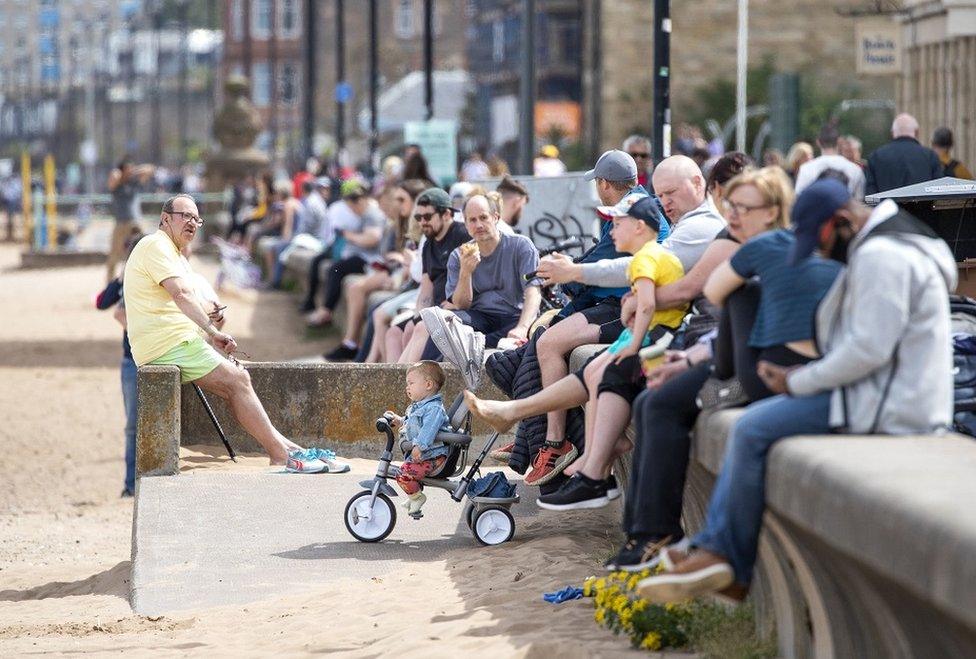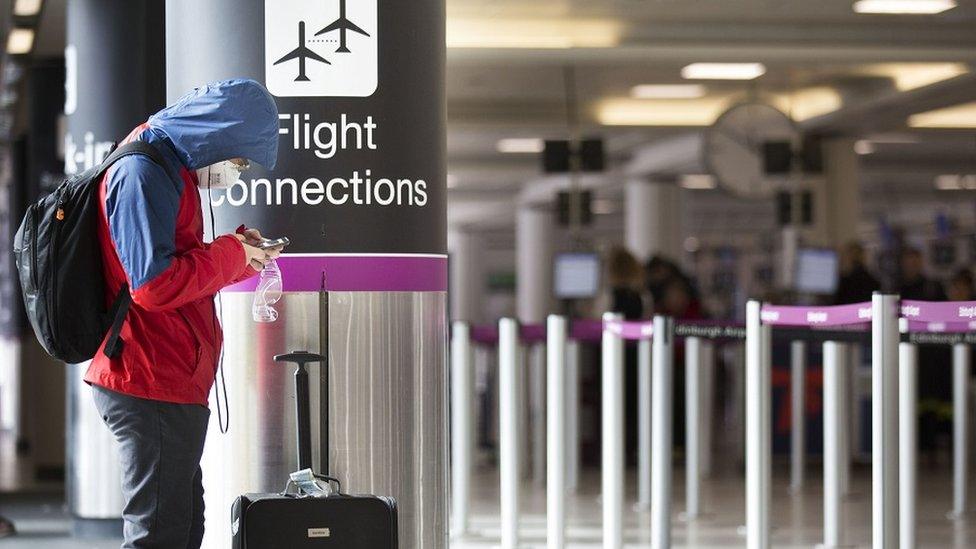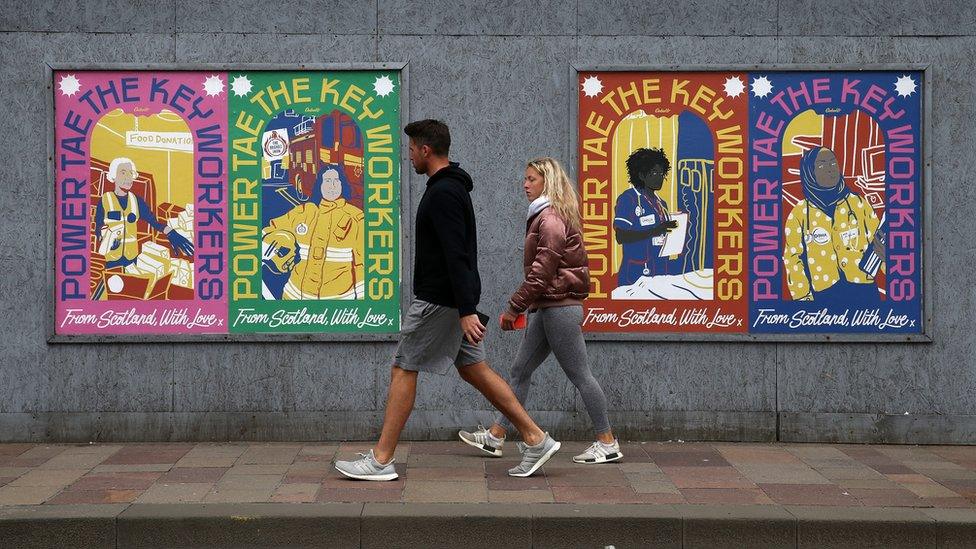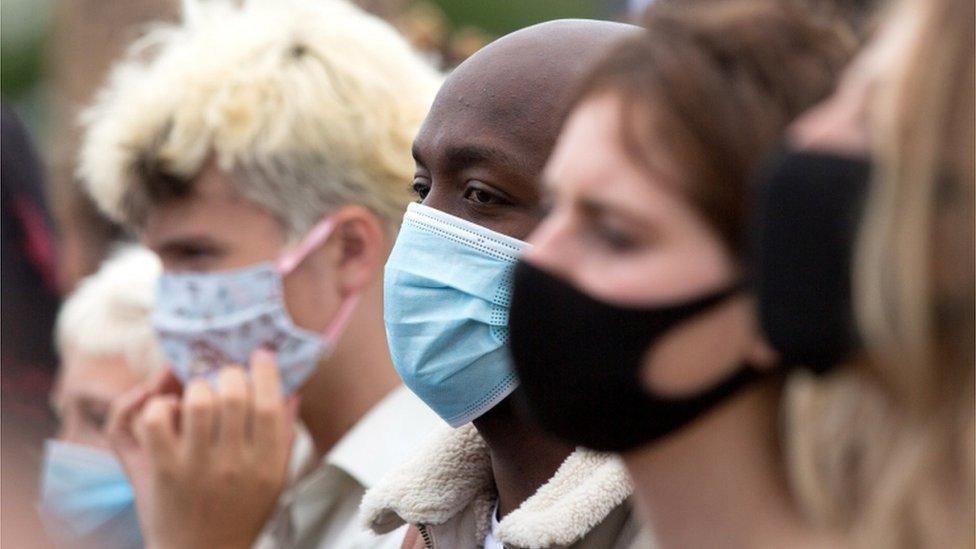How did coronavirus spread across Scotland?
- Published

Hundreds of people flocked to Edinburgh's Portobello beach at the end of May as the first stage of lifting lockdown began
A new report has shed light on how coronavirus first spread across Scotland, with suggestions the virus could have been spreading in the community before the first cases were confirmed.
What does the new study tell us about how Scotland's Covid-19 outbreak began, and how could the findings help to control future outbreaks?

International travel
The new report, external was put together by a group of Scottish academics and scientists.
They studied the genetic sequence of the virus from 452 of Scotland's first confirmed Covid-19 patients, and matched them up to strains that were circulating in other countries.
They said there had been "at least 113" introductions of the virus into Scotland during the early stages of the pandemic, and that travel to Europe was "a clear driver of the Scottish outbreak".
Early patients were found to have strains of the virus closely related to those circulating in countries including Italy, Austria and Spain - at this point, many patients had recently travelled to these countries. There were comparatively few direct links to China and south-east Asia, where the pandemic originated.

By the time travel restrictions and advice to quarantine on returning from virus hotspots had been issued, it was already too late - the virus was already spreading rapidly within the community.
The first confirmed case of Covid-19 in Scotland was a man from Tayside who had been to a rugby match in Italy in mid-February. Within three days, the first case of someone who had not been abroad was confirmed - community transmission was already taking place.
Emma Thomson, professor of infection diseases at the MRC-University of Glasgow Centre for Virus Research, said the evidence indicated there had been "earlier introduction to Scotland and community spread before the first detected case".
She added: "It is possible an earlier lockdown from countries with a high burden of cases, such as Italy, and other measures such as quarantine of travellers from high-risk areas, might have prevented escalation of the outbreak and multiple clusters of ongoing community transmission."

Community transmission

The study suggests that coronavirus quickly took hold in Scotland and began spreading between people who had not been abroad.
The authors said there was a "dramatic shift" from cases associated with travel to "sustained community transmission" within 10 days of the first detected case.
The study highlighted four early "clusters" of the virus in Scotland. One, in Shetland, was linked to people who had travelled back from Italy. Another, in the Greater Glasgow area, was linked to travel from Spain.
However, a "large" outbreak was recorded across the central belt from 13 March onwards without any apparent foreign links, while another was detected at a care home which was "not associated with any known travel".
The authors said that "community transmission was quickly established in Scotland, well before the introduction of 'lockdown' countermeasures on 23 March".

The Nike conference

One of the first virus outbreaks in Scotland occurred at an international conference in Edinburgh by sportswear giant Nike.
The conference was held on 26 and 27 February - days before Scotland's first case of the virus was confirmed - and led to "multiple local cases".
The effect of this outbreak within the UK seems to have been contained within a month, with the last case linked to it occurring on 27 March. The Scottish government highlighted a passage of the report saying that "the local public health response to this event may have been effective and [it] did not account for the majority of cases in Scotland".
However, the authors also said the geographic spread of this outbreak was "striking", spanning four continents and 10 countries from Ecuador to Australia.
They said: "The role of this event in dispersing the virus locally and internationally - before a single case had been identified in Scotland - demonstrates that governments should be wary of prematurely relaxing restrictions on large gathering and international travel."

Vaccine 'should be possible'

One of the scientists involved in the study, Prof Emma Thomson, told the BBC's Good Morning Scotland programme that she believed there was a "good chance" a vaccine would be found.
She said: "One of the reasons why we struggle for flu, and why we have to vaccinate every year for flu, is because it's so variable.
"This virus doesn't seem to be anything like as variable as that. I think there's a good chance we'll get a vaccine that might work."
Prof Thomson also said the virus "does not look man-made" and appeared to have evolved naturally, most likely from bats.
She added: "If a virus is man-made you might expect to see bits of it that would contain pieces of known virus, for example, and that wasn't the case with this virus.
"So there is no evidence to suggest that it is man-made."
What does the Scottish government say?

The authors say the study of the virus is "ongoing work" and the report has not yet been peer reviewed.
While interim chief medical officer Gregor Smith highlighted the "cutting edge" report at the government's daily coronavirus briefing on Tuesday, he said it was "really important we are careful" about drawing conclusions from it.
He said while there could have been some cases apparent in Scotland in February, "the reality is they're likely to have been very few in number".
First Minister Nicola Sturgeon said "none of the broader evidence" she had looked at suggested there had been a sharp rise in "excess" deaths above the historical average at that point.
She said: "If you look at hospital admissions, intensive care admissions and deaths, the increase and the spike of all these came from sort of late March through to April, so there is no indication from all of that data that there was a significant issue in February."
However, she said her government would continue to study the data and learn any lessons which could be drawn from it going forward.
- Published9 June 2020
